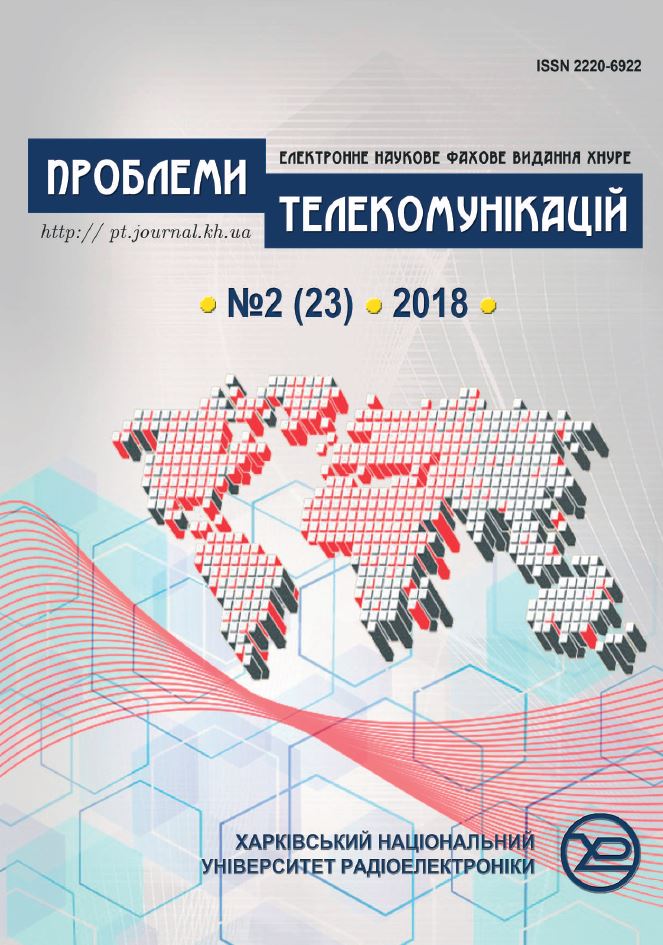The approximation of optical signals by short laser pulses in the form of a hyperbolic secant
DOI:
https://doi.org/10.30837/pt.2018.2.04Keywords:
Laser pulse, Signal envelope, Unit approximation theorem, TrafficAbstract
At present time have been developed methods to improve the signal bandwidth of fiber-optical transmission systems (FOTS). A special case of such methods is considered in earlier works of the author. The essence of the proposed methods is to transfer more than one bit of information in one clock interval. The fundamental complexity of the implementation of such methods is the need to form a low-frequency component (envelope) of an optical signal of a given shape. A solution to this problem is proposed using a single laser pulse. In this case, the laser pulse is fed to the inputs of optical amplifiers, and from their outputs - to the inputs of delay lines with a precision step. As a result of the summation of the signals from the outputs of the delay lines, an approximant of a given optical signal is formed. This article assumes that the laser pulse has the form of a hyperbolic secant. A proof of the convergence of the corresponding approximants to functions of a given type is given. A numerical analysis confirming the solutions has been also performed. It is shown that the rate of convergence is of the order of 1/N, where N is the number of approximating pulses (the number of delay lines). It is shown that the proposed solutions are consistent with the characteristics of modern FOTS and can be implemented at the existing technological level of manufacturing optical components.References
Odegov, N.A. (2017), “Transmission of information by optical pulses of equal dispersion” [“Peredacha informatsii opticheskimi impul'sami ravnoy dispersii”], Scientific works of ONAT named after O.S. Popov, (2), P. 28-38.
Vlasov, O.M., Katok, O.V., Shpak, V.M. (2006), “Using nonlinear fiber optic effects for temporal compression of optical pulses” [“Vykorystannya neliniynykh efektiv volokonnykh svitlovodiv dlya chasovoyi kompresiyi optychnykh impulʹsiv”], Zvyazok, (2), P. 42-47.
Soto, M.A., Alem, M., Shoaie, M.A., Vedadi, A., Brès, C.S., Thévenaz, L. and Schneider, T. (2013), “Optical sinc-shaped Nyquist pulses of exceptional quality”, Nature communications, (4), P. 1–11. DOI: https://doi.org/10.1038/ncomms3898.
Zhang, J., Yu, J. and Chi, N. (2015), “Transmission and full-band coherent detection of polarization-multiplexed all-optical Nyquist signals generated by Sinc-shaped Nyquist pulses”, Scientific reports, (5), P. 1-13. DOI: https://doi.org/10.1038/srep13649.
Wetzel, B., Kues, M., Roztocki, P., Reimer, C., Godin, P.L., Rowley, M., Little, B.E., Chu, S.T., Viktorov, E.A., Moss, D.J. and Pasquazi, A. (2018), “Customizing supercontinuum generation via on-chip adaptive temporal pulse-splitting”, Nature communications, (9), P. 1-10. DOI: https://doi.org/10.1038/s41467-018-07141-w.
Odegov, N.A. and Stepanov, D.M. (2018), “Formation of a low-frequency component of an optical signal by pulses of a gaussian form”, Information and Telecommunication Sciences, (1), P. 26–33. DOI: https://doi.org/10.20535/2411-2976.12018.26-33.
Odegov, N.A., Starenkiy, I.V. and Kostjuk, V.V. (2018), “Formation of piecosecond optical pulses of the assigned structure using precision lines of delay”, Proceedings of the O.S. Popov ONAT, (1), P. 34–43.
Odehov, N.A., Kovtun, I.I., Petrashchuk, S.V. and Tertychnyy, R.A. (2018), “Fundamentals of the theory of optical signal approximation by Gaussian pulses” [“Osnovy teoryy approksymatsyy optycheskykh syhnalov haussovymy ympulʹsamy”], Visnyk Khmelʹnytsʹkoho natsionalʹnoho universytetu. Tekhnichni nauky, (5), P. 42-72.
Akhmanov, S.A., Vysloukh, V.A. and Chirkin, A.S. (1988), Optics of femtosecond laser pulses [Optika femtosekundnykh lazernykh impul'sov], Nauka, Moscow, 312 p.
Measurement of pulse duration by the method of two-photon photoluminescence [Izmereniye dlitel'nosti impul'sa metodom dvukhfotonnoy fotolyuministsentsii], available at: http://pstu.ru/files/file/oksana/2012/innovacii/pnr/pnr3/nelenejnye_effecty/lekciya13.pdf.
Prudnikov, A.P., Brychkov, Yu.A. and Marichev, O.I. (1981), Integrals and Series. Elementary functions [Integraly i ryady. Elementarnyye funktsii], Nauka, Moscow, 800 p.
Makarov, T.V. (2009), Coherent fiber optic transmission systems [Kogerentnyye volokonno-opticheskiye sistemy peredachi], O.S. Popov ONAT, Odesa, 220 p.
Downloads
Published
Issue
Section
License
Copyright (c) 2018 Odegov Nickolai

This work is licensed under a Creative Commons Attribution-NonCommercial-ShareAlike 4.0 International License.
Authors who publish with this journal agree to the following terms:- Authors retain copyright and grant the journal right of first publication with the work simultaneously licensed under a Creative Commons Attribution License that allows others to share the work with an acknowledgment of the work's authorship and initial publication in this journal.
- Authors are able to enter into separate, additional contractual arrangements for the non-exclusive distribution of the journal's published version of the work (e.g., post it to an institutional repository or publish it in a book), with an acknowledgment of its initial publication in this journal.
- Authors are permitted and encouraged to post their work online (e.g., in institutional repositories or on their website) prior to and during the submission process, as it can lead to productive exchanges, as well as earlier and greater citation of published work (See The Effect of Open Access).

